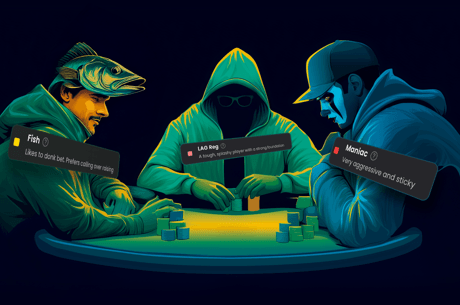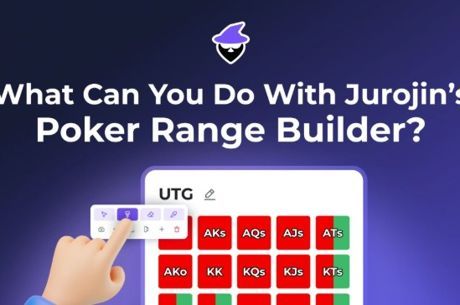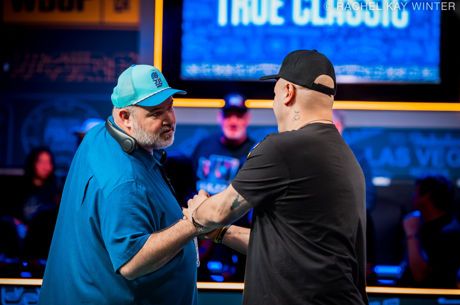H.O.R.S.E. Poker Strategy -- In the Mix: Playing the River in Limit Hold'em

Four weeks ago I wrote about some of the difference between playing no-limit hold'em and limit hold'em, a game which is the cornerstone of many a mixed-game rotation and one of the primary games in most mixed-games tournaments, whether the format is H.O.R.S.E, S.H.O.E., mixed-limit / no-limit hold'em or some other variant. One of the differences I mentioned is that the river plays much differently in limit hold'em. I mentioned that it's often difficult to bluff-raise the river, but bluff-betting the river can sometimes be successful. This week I want to take a closer look at when and why bluffs on the river in limit hold'em can be successful, in order to better illustrate some of the fundamental concepts involved in river play.
A hand I recently played is a good starting point for the discussion. I opened the pre-flop betting from early position with A♠A♣. The player in the cutoff position had just joined the table and posted a blind. He called, as did the actual big blind in the hand. I knew both players reasonably well. The big blind played most streets on the passive side and could be calling with a wide range of reasonable starting hands. The cutoff player was a touch loose preflop but quite tight after the flop and was much more aggressive than the big blind. The cutoff's biggest weakness that I had identified during previous sessions was that he tended to overplay top pair — especially against me. He had seen me ram and jam the flop on a few occasions when I flopped a strong combination draw in a multi-way pot and thereafter tended to give my flop bets and raises less credit.
The three of us took a flop of Q♦6♣7♦, a pretty good flop for my hand but a very draw-heavy board. After the big blind checked the flop to me, I bet and was quickly raised by the cutoff. That made it two bets back to the big blind, who called. Normally in such a situation my antennae would be raised, looking for signs of strength from the big blind. If the board had been less well connected it would have been more cause for alarm to see the big blind call the two bets, but on that board and knowing the player as I did I was convinced that my aces were still the best hand. It also seemed to me that the cutoff was probably raising with a single pair of queens (six-seven was possible, but a queen more likely). These thought processes led to a three-bet on my part, which the cutoff capped. We all called to the turn.
The turn came J♣ and again the big blind checked. I bet my aces again, largely to see what the cutoff player would do. I knew he would not raise without two pair or better on the turn; when he just called, I narrowed my read to queen-ten, king-queen or ace-queen. When the big blind called, I figured her for some kind of draw. Diamonds seemed like a reasonable guess.
Thus I was very unhappy to see the 2♦ hit the river, and even more unhappy to see the big blind bet it. With all of the action, there were twelve big bets on previous streets, plus the big blind's river bet. I was getting 13-to-1 to call here, with a hand that was definitely ahead of the cutoff. The big blind was savvy enough to realize that, with all of that money in the pot and with two opponents in the hand, there was no way she would be able to bluff both of us out of the hand. After another moment of unhappy deliberation, I mucked my hand. The cutoff player called.
"I missed," said the big blind, tabling 8♠ 9♣. The cutoff showed A♥ Q♠ for top pair, top kicker and I started internally questioning my play and the play of the big blind. The pot was laying me 13-to-1, and I was almost certain that I could beat the third player in the hand — the player in the cutoff. Thus, I was in a situation where, if the big blind would bluff at least 1 in 13 times on this river, it was profitable for me to call.
That's where I got stuck. I convinced myself that, because of the size of the pot and because of the fact that two opponents had gone all the way to the river with the big blind (each one putting in his share of bets and raises), there was no way the big blind could possibly think a bluff would work on this river. For any bluff to be successful, it must be successful against all remaining players in the pot, not just one. There's a concept in limit poker of a "protected pot" — a pot where there are enough players left in a hand after all of the cards are out that any bluff will likely be called by at least one of the remaining players. Knowing that the big blind assumed that at least one of us would call, I convinced myself that the likelihood that the big blind was running a bluff was almost nil and that she must have made a flush. That's why I folded.
Of course, just because I know these concepts doesn't necessarily mean my opponents do. It's a classic poker trap — we analyze the hand from the perspective of our opponents not in the way they might think through the hand, but the way we would think through the hand if we were in their shoes. In this particular instance, the player in the big blind (who was more used to playing no-limit hold'em than she was to playing limit hold'em) recognized the scare value of the river diamond and felt she could make a reasonable play at it with a bluff. It would be an excellent play in no-limit hold'em. The story told by her previous actions on the flop and turn matched a river bet once the flush hit. The problem was that, unlike no-limit hold'em, she couldn't make a big enough bet to scare multiple people out of the pot. With the pot laying such a good price, and with there being so much previous action, and with the fact that one player in the hand (the cutoff) consistently overplayed top pair, there was no chance of this bluff being successful.
If I had stopped to consider that the big blind might not be aware of the overwhelming likelihood of one of the two of us calling her bet, I probably would have been more inclined to make a crying call on the river. It would have been correct to do so if I thought she would bluff at least 8% of the time. Given that the river was a "scare card", imagining a player bluffing at least 8% of the time is not hard to do.









